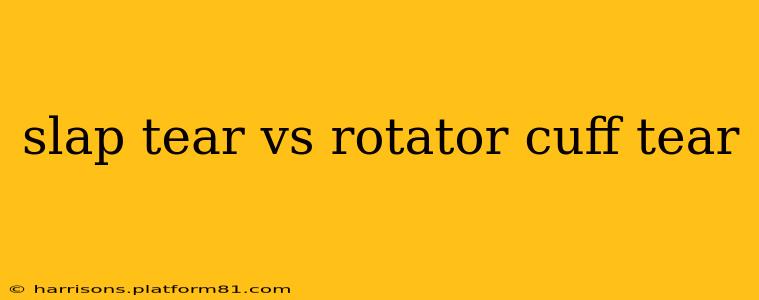Shoulder pain is a common ailment, often stemming from injuries to the complex network of muscles and tendons that stabilize and move the joint. Two frequent causes of shoulder pain are slap tears and rotator cuff tears. While both can be debilitating, they affect different parts of the shoulder and have distinct characteristics. This article will delve into the key differences between slap tears and rotator cuff tears, helping you understand the nuances of these injuries.
What is a SLAP Tear?
A SLAP (Superior Labrum Anterior to Posterior) tear is an injury to the labrum, a ring of cartilage that surrounds the shoulder socket. It's located where the biceps tendon attaches to the top of the shoulder joint. Specifically, a SLAP tear involves damage to the superior labrum, the portion of the labrum located at the top of the shoulder socket, extending from the front (anterior) to the back (posterior). These tears can range from minor fraying to complete detachments.
Types of SLAP Tears:
SLAP tears are categorized into different types based on the extent and location of the damage:
- Type I: Mild stretching or fraying of the labrum.
- Type II: A tear of the labrum that also involves the biceps tendon. This is the most common type.
- Type III: A bucket-handle tear of the labrum where a portion of the labrum is detached but still attached at one end.
- Type IV: A bucket-handle tear that also involves the biceps tendon.
What is a Rotator Cuff Tear?
The rotator cuff is a group of four muscles and their tendons that surround the shoulder joint, providing stability and enabling a wide range of motion. A rotator cuff tear occurs when one or more of these tendons are torn. These tears can range from small partial tears to complete tears, where the tendon is completely separated from the bone.
Common Rotator Cuff Muscles and their Roles:
- Supraspinatus: Initiates abduction (lifting the arm away from the body).
- Infraspinatus: External rotation (rotating the arm outward).
- Teres Minor: External rotation (rotating the arm outward).
- Subscapularis: Internal rotation (rotating the arm inward).
Slap Tear vs. Rotator Cuff Tear: Key Differences
While both injuries can cause significant shoulder pain and dysfunction, there are key distinctions:
| Feature | SLAP Tear | Rotator Cuff Tear |
|---|---|---|
| Location | Superior labrum (top of shoulder socket) | Rotator cuff tendons |
| Affected Area | Labrum and sometimes biceps tendon | One or more rotator cuff tendons |
| Mechanism | Often from sudden overhead movements | Often from repetitive movements or trauma |
| Symptoms | Clicking, popping, catching, weakness, pain with overhead activities | Pain, weakness, limited range of motion, pain at night |
What are the symptoms of a SLAP tear?
Symptoms of a SLAP tear can include:
- Pain: Deep pain in the shoulder, often worsened by overhead activities.
- Instability: Feeling of the shoulder giving way or popping out.
- Weakness: Difficulty lifting or rotating the arm.
- Clicking or Popping: Sounds heard in the shoulder joint during movement.
- Limited Range of Motion: Difficulty performing everyday activities.
What are the symptoms of a rotator cuff tear?
Symptoms of a rotator cuff tear can include:
- Pain: Shoulder pain, particularly at night or when resting.
- Weakness: Difficulty lifting or rotating the arm.
- Limited Range of Motion: Inability to fully raise or rotate the arm.
- Crepitus: A grating or crunching sound or sensation in the shoulder joint.
Can you have both a SLAP tear and a rotator cuff tear?
Yes, it is possible to have both a SLAP tear and a rotator cuff tear simultaneously. These injuries often occur together because they both involve structures located in the shoulder joint. The presence of both injuries can significantly increase shoulder pain and dysfunction, warranting prompt medical attention.
How are SLAP tears and rotator cuff tears diagnosed?
Diagnosis usually involves a physical exam and imaging studies. Magnetic resonance imaging (MRI) is often the preferred imaging modality, as it provides detailed images of the soft tissues in the shoulder. Arthrograms (MRI arthrography) may be used to better visualize the labrum. X-rays are useful to rule out fractures or other bony abnormalities.
This information is for educational purposes only and is not intended as a substitute for professional medical advice. Always consult with a qualified healthcare professional for any health concerns or before making any decisions related to your health or treatment.
